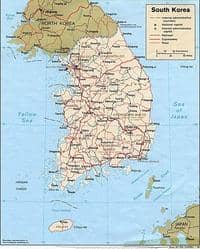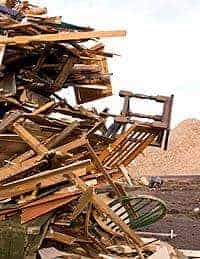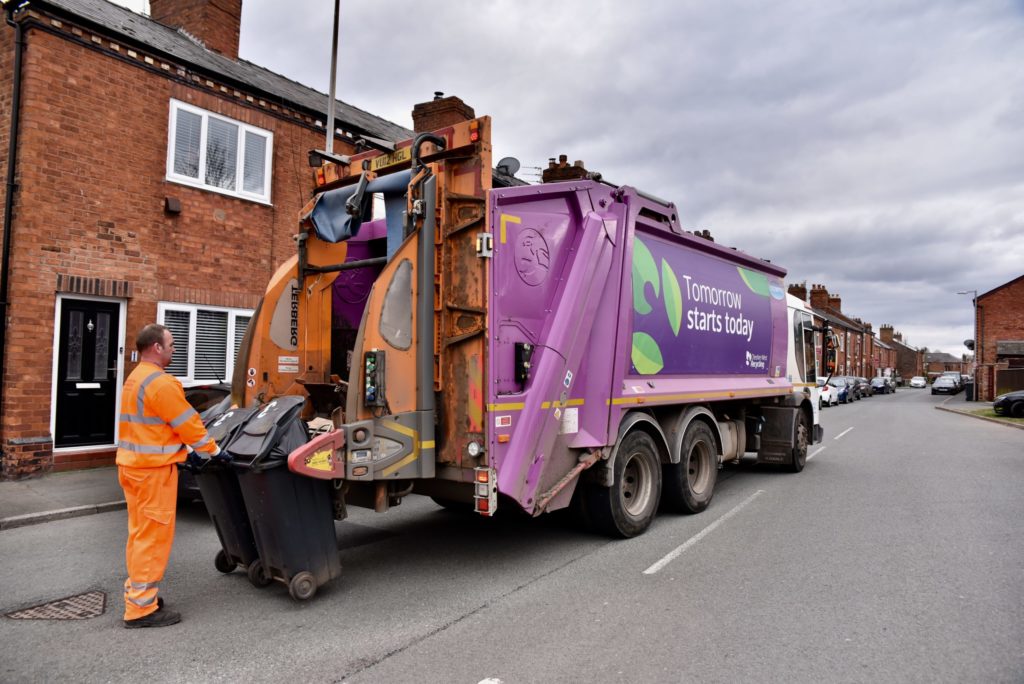I was recently in Daegu, 300km away from Incheon National Airport, the largest airport in South Korea, at the invitation of the Korea Society of Waste Management (KSWM) to talk about the European approach to waste management and climate change. For the past 13 years there have been joint sessions between the KSWM and the Japan Waste Management Association. However, earlier this year the Japanese organisation changed its name to the Japan Society of Material Cycles and Waste Management (JSMCWM) in order to recognise their increasing emphasis towards resource efficiency.
This special session on climate change was in addition to a session on urban biomass and waste to energy. Both in South Korea and Japan the International Solid Waste Association (ISWA) national members are dominated by academics. Therefore were also several “poster sessions” with materials presented mainly from postgraduate students.
The sessions were held in English, partly because it is the lingua franca for the whole of the scientific community but also it enables both the South Korean and Japanese academics to access a wider waste community. Indeed, after several years of discussions the South Koreans and Japanese have agreed to the production of a new waste management journal, with the papers to be published in English, naturally. The agreement was signed before the formal conference dinner.
Climate change
The climate change session was opened by a presentation on 'The Global Responses on Climate Change' by Rae-Kwan Chung, the senior official from the Ministry of the Environment responsible for climate change issues in South Korea. He noted that South Korea, an OECD country had the highest growth rate of GHG emissions among the OECD countries, 5.1% pa over the period 1990 to 2004. He also noted that the carbon reduction productivity growth required to meet international targets would be very difficult to achieve in the context of historic improvements in productivity recorded elsewhere, such as labour productivity or even energy efficiency. Although Mr Chung emphasised the importance of the growth of green jobs in combating climate change these seem to have little current applicability in South Korea.
Dr Masato Yamada of the Research Centre for Material Cycles and Waste Management within the National Institute for Environmental Studies in Japan talked about 'Reduction of GHG from MSW: experience in Japan and its application to Asia'. Dr Yamada noted that according to the 2007 IPCC (International Panel on Climate Change) report 2.8% of anthropogenic GHG emissions are attributable to waste and waste-water treatment activities. This is the smallest of the sectors specifically identified and is insignificant compared to:
• Energy supply 25.9%
• Transport 13.1%
• Agriculture 13.5%
• Forestry 17.4%
• Residential and commercial buildings 7.9%
However, some of the waste sector's emissions might well be included within other sectors' emission totals. The analysis from the UNFCCC (United Nations Framework Convention on Climate Change) in 2005 shows that in Asia the waste sector accounts for 3.7% of total GHG emissions, of which the overwhelming majority is accounted for by landfill gas emissions.
Professor Byung-Ran Lim of the Seoul National University of Technology examined 'CDM Project Status and GHG Reduction Technology in Environmental Facilities' providing a detailed perspective on GHG emissions from waste-related facilities. Of the total 2005 South Korean GHG emissions of 591.1m tonnes CO2equivalent only 13m tonnes (2.2%) is estimated to come from waste facilities, specifically:
• Landfills 6.1m tCO2eq
• Incineration 5.8m tCO2eq
• Sewage treatment 1.1m tCO2eq
• Other waste related 0.1 m tCO2eq Source: Ministry of Knowledge Economy
With South Korea's domestic CDM (clean development mechanism) projects several of the bigger schemes focus on emission reductions from the waste sector, such as:
The Daegu Bangcheon-Ri landfill gas project which generates 404,872 tCO2/year and the Sudokwon landfill gas electricity generation project (50MW) which generates 1,210.342 tCO2/year.
In addition, there are a number of sectors where process management changes are being effected, such as changing sewage treatment to ensure methane recovery and methane recovery from animal manure management, particularly those from intensive indoor animal feeding systems.
I examined Waste Management and GHG Reduction in Europe. I emphasised that the waste sector in Europe was still trying to assess how much it is contributing and the ways the sector can reduce its GHG impact in the future. However, the 2007 English waste strategy, unusually among European waste strategies, had included a specific GHG reduction target for 2020.
There were many questions, including what were the GHG impacts of waste flows within and outside of the EU, including exports to SE Asia. The recent WRAP report produced by Oakdene Hollins showed the positive contribution which such exports can make in overall reductions of GHG emissions. Subsequently during the discussions it was admitted that even Japan was increasingly exporting its recyclable wastes.
Professor Jin-Won Park from Yonsei University made a presentation on 'Generation and Management of GHG in Environmental Facilities'. His presentation focused on nitrous oxide emissions from different types of WtE (waste-to-energy) facilities, looking at international experience compared to current South Korean practice. Nitrous oxide emissions are significantly higher for sewage sludge incinerators compared to waste incineration plants of all types.
Biomass and Waste to Energy
The other joint session on the theme of 'Urban Biomass and Waste to Energy' comprised 4 papers and 19 posters covering a wider range of waste and resource topics. For me it was interesting to compare South Korea's situation to that of the UK, or more specifically England, because the population of South Korea is just under 50m and England just over, while the land area of South Korea at 100,000km2 is 30% less than England.
The opening presentation by Byung-chul Choi from the Ministry of Environment focused on South Korea and the potential 'Promotion of a Comprehensive Master-plan for Waste to Energy'. Because of its industrial balance, with a preponderance of heavy engineering, South Korea is currently the 10th biggest energy consuming nation in the world, it imports 97% of its energy requirements and is therefore urgently developing plans to reduce this dependence on energy imports.
As at 2006 the contribution of renewable energy sources was only 2.24% of total energy requirements but with government plans to increase the proportion to 5% by 2011. 76% of renewable energy is currently sourced directly or indirectly from waste and its cost of production is only 10% that of solar energy and 66% of wind energy. In contrast the proportion of renewable energy used in the UK was 3.2% in 2006, 3.5% in 2007 and even now with only about 6% of electricity generated from renewable sources.
South Korea's GHG discharge in 2005 was 591m tonnes and had been increasing on average by 4.7% pa since 1990, making Korea the OECD nation with the highest rate of increase.
Energy
There are several drivers pushing Korea towards greater use of WtE technologies, including the London Convention – 1996 Protocol that took effect in March 2006, under which the dumping of waste into ocean waters has been banned. However, in 2006 South Korea was dumping 20,000 tonnes per day of sewage sludge into the sea and therefore needed to move to land disposal, although it still seems to be using some ocean dumping currently. Moving to land disposal through landfill would give rise to landfill safety and odour problems plus higher GHG emissions as well. To achieve GHG reductions the bio-gasification of these wastes, rather than incineration, should be utilised.
The presentation then focussed on what was happening in the EU and Japan. As is often the case when looking at these issues from outside they were presented with a more favourable picture than the reality.
Of the South Korean total of 5.23m tonnes of oil equivalent (TOE) of renewable energy produced in 2006 WtE amounted to about 4m TOE, mainly from incineration facilities and also landfill gas capture. However, detailed analysis of the contribution of South Korea's incineration facilities shows that only a minority have any energy recovery. Of the power generation the vast majority (80%) is used within the plant and 35% of the heat is also used by the plants. With the landfill gas developments 11 produce electrical power rated at 81 MW total capacity and in 4 cases gas is supplied directly for other users at a total rating of 900,000 m3 per day.
In common with the UK Government's waste management priorities, in South Korea there has been an emphasis on material recycling and very little encouragement of energy recovery. The Ministry of Knowledge and Economy mainly supports solar, wind, hydropower and geothermal sources of renewable energy. In a statement from the Ministry in mid-2008 they stated that the country will spend $193m on solar, wind and biofuels. For the future South Korea is looking to develop RDF production as well as energy from incineration capacity. Indeed, following at statement from the President on South Korea's last National Day on 13 August 2008 there will be incentives for use of waste as a fuel only in non-waste related plant.
As with the UK there is a huge potential for the further development of energy from waste sources. However, there currently seems to be little positive push from the government despite the obvious advantages of undertaking such investments. In Korea's case these could include: 17,000 green jobs through the establishment and operation of WtE facilities, decreasing landfill to less than 20% of current volume and utilisation of at least a further 12m tpa of combustible and organic wastes, much of which could be brought on stream by 2012 if the government were so inclined.
Kazuo Nakamura, Manger for Biomass in the Facilities Department of the Environment Bureau of Kyoto City outlined 'Kyoto City's Biomass Utilization Initiatives'. As the birthplace of the pioneering Kyoto Protocol naturally the City feels that it should be in the lead in reducing their GHG impacts. However, compared to the base year 1990 emissions have remained the same, but that is better than the average for the Japanese economy where emissions rose 8% by 2005 compared to 1990.
Oil
Kyoto is focussing on biomass utilisation, including projects to recycle households' used cooking oil into bio-diesel and for bio-gas production from kitchen waste and the waste glycerin generated as a by-product of bio-diesel production. The bio-diesel project was started in 1997 and there are now 1,300 collection points throughout the City producing 160,000 litres pa. From 1997 this was used as fuel for the city's 220 refuse trucks and from 2000 also for 80 of the city's buses (now increased to 95). The 160,000 litres of bio-diesel used in these vehicles enables the City to reduce CO2 emissions by about 4,000 tpa.
In 2004 a new 5,000 litres per day bio-diesel plant became fully operational. This produces bio-diesel to a provisional fuel quality standard, “the Kyoto standard”, which was set by a Technology Committee of academics and other experts. In addition, a 'Biodiesel Handbook' has been published, edited by Professor Makoto Ikegami, to disseminate the knowledge acquired through the development of Kyoto's bio-diesel project.
In the 'Plan for Waste Disposal' that it drew up in 1998 Kyoto City set objectives for the retrieval of resources and energy from waste, including the gasification of kitchen waste. In 1999 a government-funded pilot plant started operation and over the following 3 years tests were conducted using hotel kitchen and market wastes as the main raw material combined with different mixes of tree trimmings and used paper.
A further plant to deal with most of the city's food waste is scheduled to come into full operation in 2013 but there are several issues that have also to be addressed, including:
• Reduction of fermentation residues, currently at 40% of the waste used to produce the biogas (there are plants in Europe where 10% is the operating norm)
• Reducing the waste water arising from the dilution of raw materials (again some European plants use this as a liquid bio-fertiliser), and
• Progressing the development of hydrogen generation technology for stable and efficient extraction of hydrogen from bio-gas, currently a global holy grail!
Through these and other measures Kyoto hopes that it can reduce its CO2 emissions in 2010 and dramatically improve its overall sustainability thereafter.
Kiyohiko Nakasaki of the Department of Materials Science and Chemical Engineering of Shizuoka University, Japan examined the 'Production of Ethanol from Biomass Resources in Japan'. However, as with developments in other countries in Japan the main potential source for ethanol production focuses on the use of grain or other potential food crops. Currently the US and Brazil together produce 65% of the total bio-ethanol manufactured in the world, almost exclusively from food crops. There are small plants using waste foodstuffs and waste wood for ethanol production in Japan but these are currently not commercially viable in competition with the first generation (food sourced) production facilities.
The fourth presentation by Seong-Seok Seo from SK Engineering & Construction based in Korea examined 'Woody Biomass to Energy Technology'. Again, as in the UK, the potential contribution of wood wastes and growing of local biomass for energy production is widely recognised.
Mr Seo's presentation showed that there was a total of 7.6m tpa of waste wood available within South Korea, of which the majority is available in the form of forestry trimmings and wood waste from forest land with only a minority from industrial sources. The household sources of are miniscule reflecting the fact that most people in South Korea live in multi-storey apartment blocks and therefore potential DIY sources are limited. Also even the chopsticks used in Korea are metal reusable ones in contrast to Japan where thousands of tonnes of single use wooden chopsticks are used each year.
The wood waste resource in South Korea is sufficient to fire 8 100MW CHP units. As yet projects for turning wood waste into pellets for dedicated boilers or co-firing are at an early stage and further work will be necessary to turn wood wastes into a fuel source for pyrolysis or gasification plants in Korea. The conversion of woody biomass through hydrolysis to cellulose and then to sugar by “saccharification” and thence to bio-fuel by fermentation of the sugars is even further from commercial application in Korea but work is progressing.
Biofuels
In all the considerations of use of wastes as biofuels is the importance of the existing regime of international commitments under the Kyoto Protocol and what may succeed it after the December 2009 Convention of the Parties meeting in Copenhagen is significant. The outcome of this meeting should provide further incentives for the development of renewable energy sources from a wide variety of potential waste sources as these four papers ably demonstrated.
Outside the conference sessions I discussed Korea's approach to food waste and current approaches for dealing with it. However, before examining that I should at least describe Korean cuisine, which predominantly comprises soup and a main course and, of course, a bowl of rice but in addition numerous side dishes, all consumed together at the same time, or rather not consumed as the side dishes are mainly left untouched and the soup and main dish half eaten. This has two consequences, most Koreans are fit and lean and the food waste is huge and sloppy.
In the major cities there are now systems for the segregation of food waste so that it can be sent for separate treatment, although the facilities have not been established sufficiently rapidly to cope. Also because the waste from the main cities is usually incinerated the segregation of the food waste has increased the calorific value of the remaining waste that is being incinerated and that means the incineration plants are working less efficiently with lower quantities going through these treatment plants.












Subscribe for free